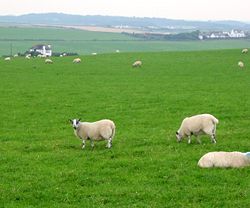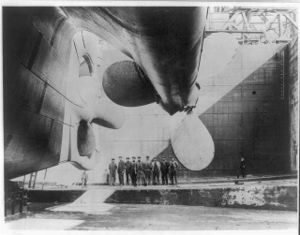Economy of Northern Ireland
2008/9 Schools Wikipedia Selection. Related subjects: Economics
The economy of Northern Ireland is the smallest of the four Home Nations' economies of the United Kingdom. Northern Ireland has traditionally had an industrial economy, most notably in shipbuilding, rope manufacture and textiles, but most heavy industry has since been replaced by services. To this day, Northern Ireland still suffers from the results of the Troubles which occurred between the late 1960s until the mid-1990s between Unionists and Nationalists.
Overview
Output and economic growth
Northern Ireland has the smallest economy of any of the twelve NUTS 1 regions of the United Kingdom, at €37.3bn, or about two-thirds of the size of the next smallest, North East England. However, this is partly because Northern Ireland has the smallest population; at €19,603 Northern Ireland has a greater GDP per capita than both North East England and Wales.
Other Comparisons
| Border Midland & Western Ireland (1.1 million) | Southern & Eastern Ireland (3 million) | Northern Ireland (1.75 million) |
|---|---|---|
| €25.5 bn GVA | €101,374 bn GVA | €37.3 bn |
| €23,637 GVA per person | €35,725 GVA per person | €19,603 per person |
Throughout the 1990s, the Northern Irish economy grew faster than did the economy of the rest of the UK, due in part to the rapid growth of the economy of the Republic of Ireland and the so-called ' peace dividend'. Growth slowed to the pace of the rest of the UK during the down-turn of the early years of the new millennium, but growth has since rebounded; in 2005, the Northern Irish economy is estimated to have grown by 3.2%, almost twice as fast as the UK as a whole, and future growth is expected to be stronger than that of the rest of the United Kingdom,, though lower than that of the Republic. In April 2007 a Halifax survey found Northern Ireland's average house price to one of the highest in the UK, behind London, the South East and the South West. It also found Northern Ireland to have all of the top ten property "hot spots", with the Craigavon and Newtownards areas increasing by 55%.
Employment
Unemployment in Northern Ireland has decreased substantially in recent years, and is now 4.5%, which is amongst the lowest of the regions of the United Kingdom, down from a peak of 17.2% in 1986. Youth unemployment and long-term unemployment have fallen most quickly. Despite low unemployment, working-age economic inactivity is 28%, which is the highest of any UK region.
Northern Ireland's macroeconomy is also characterised by considerably longer actual working hours and lower gender income disparity than in the United Kingdom as a whole.
Investment
During The Troubles, Northern Ireland received little foreign investment. Many believe this to be the result of Northern Ireland's portrayal as a warzone in the media, by both British and International during this period.
Since the signing of Good Friday Agreement investment in Northern Ireland has increased significantly. Most investment has been focused in Belfast and several areas of the Greater Belfast area. Major projects include the £400 million Victoria Square retail development in Belfast City Centre. The city will also see the largest waterfront development in Europe with the Titanic Quarter scheme, costing over £1,000 million and taking seven years to complete. The Laganside Corporation has been at the forefront of the redevelopment of the riverfront along the banks of the River Lagan, to date the corporation has overseen the investment of over £800 million in the riverside area. The Cathedral Quarter has also seen substantial investment.
Agriculture

Agriculture in Northern Ireland is heavily mechanised, thanks to high labour costs and heavy capital investment, both from private investors and the European Union's Common Agricultural Policy. In 2000, agriculture accounted for 2.4% of economic output in Northern Ireland, compared to 1% in the United Kingdom as a whole. As in the rest of the United Kingdom, livestock and dairy account for the majority of agricultural output. The main crops are (in descending order of value) potatoes, barley, and wheat.
Manufacturing

Heavy industry is concentrated in and around Belfast, although other major towns and cities also have heavy manfufacturing areas. Machinery and equipment manufacturing, food processing, and textile and electronics manufacturing are the leading industries. Other industries such as papermaking, furniture manufacturing, aerospace and shipbuilding are also important, concentrated mostly in the eastern parts of Northern Ireland. Of these different industries, one of the most notable is that of Northern Ireland's fine linens, which is considered as one of the most well-known around Europe.
Although its share of economic output has declined, manufacturing output in Northern Ireland has remained almost unchanged over the past five years, after a period of steep manufacturing growth between 1998 and 2001. However, this overall picture of health hides a dramatic shift in manufacturing priorities, with the decline of traditional industries, such as textiles and shipbuilding, at the expense of high tech and capital-intensive industries. In 2005, chemicals and engineering (both of which belong firmly to the latter group) were the only two manufacturing sub-sectors to record growth, whilst output of textiles fell by 18%.
Engineering is the largest manufacturing sub-sector in Northern Ireland, particularly in the fields of aerospace and heavy machinery. Bombardier Aerospace is the province's largest industrial employer, with 5,400 workers at five sites in the Greater Belfast area. Other major engineering employers in Northern Ireland include Bombardier Aerospace, Caterpillar, DuPont, Emerson Electric, Nortel, Northbrook Technology, Seagate and NACCO. Many of these manufacturers receive British government financial backing, and enjoy close academic and business links with Queen's University Belfast, which ranks as one of the best British universities for all engineering courses.
Services
As with all developed economies, services account for the majority of employment and output. Services account for almost 70% of economic output, and 78% of employees.
Tourism
Despite the negative image of Northern Ireland held in many foreign countries, on account of the Troubles, tourism is an important part of the Northern Irish economy. In 2004, tourism revenue rose 7% to £325m, or over 1% of the local economy, on the back of a rise of 4% in total visits to 2.1m in the year. Tourism is considered likely to become one of the main growth areas of the economy in the near future, with the continuation of the peace process and the normalisation of the image of Northern Ireland internationally. The most popular tourist attractions include Belfast, Armagh, the Giant's Causeway, and Northern Ireland's many castles.
Public sector
The public sector accounts for 63% of the economy of Northern Ireland, which is substantially higher than 43% of the United Kingdom as a whole. In total, the British government subvention totals £5,000m, or 20% of Northern Ireland's economic output.
Many Unionists in Northern Ireland argue that a United Ireland could not sustain these levels of public sector employment, particularly as only 36% of the economy of the Republic of Ireland is contributed by government expenditure. Many in favour of a United Ireland argue that it is this dependence on the public sector that dissaudes potential investors, causing Northern Ireland's relative poverty.
Currency
The official currency in use in Northern Ireland is the British Pound sterling. The euro, in use in the Republic of Ireland, is accepted by retailing chains closer to the border with the Republic of Ireland, Sterling however remains Northern Ireland's legal tender and the most widely circulated currency.
In addition, four Northern Ireland banks retain the right to print their own sterling-denominated banknotes: Bank of Ireland, First Trust Bank, Northern Bank, and Ulster Bank. These notes are circulated alongside, and in parity with, official Bank of England banknotes in Northern Ireland. However, they are often rejected by people in the rest of the United Kingdom, many of whom are unaware of the legitimacy of the notes. The Northern Bank robbery brought to national and international attention the Northern Irish system.
Energy
| Primary energy consumption | ||
|---|---|---|
| Source | ktoe | % |
|
|
||
| Coal | 1,440 | 29.4 |
| Oil & LPG | 1,290 | 26.3 |
| Natural Gas | 1,100 | 22.4 |
| Vehicle fuel | 926 | 18.9 |
| Renewables | 10 | 0.2 |
| Electricity imports | 140 | 2.8 |
|
|
||
| Total | 4,900 | 100 |
Northern Ireland's total primary energy consumption is approximately 4.90 million tonnes of oil equivalent. The vast majority of this energy comes from fossil fuels.
Electricity consumption in Northern Ireland was 7,867 GW·h in 2002/3. At 4.6 MW·h per person, this is 18% less than that of the rest of the United Kingdom (5.6 MW·h per person); although this may be expected of a less prosperous region, Northern Ireland's relative energy efficiency is seen as a successful transitional from its once heavily industrialised economy to a less energy-reliant services-based one. The main power station is located at Ballylumford, and is operated by Premier Power.
Northern Ireland's electrical grid is connected to that of the Republic of Ireland by three cross-border interconnectors. The main interconnector, between Tandragee and Louth has a capacity of 1,200 MW. Two back-up interconnectors have a combined capacity of 240 MW. This combined all-island grid is connected to the National Grid on the island of Great Britain by the 500 MW Moyle interconnector, under the North Channel.
Transport
Northern Ireland has well-developed transport infrastructure. Northern Ireland has a total of 24,820 km (15,420 mi) of roads, or 1 km for each 68 people (1 mi for each 109 people), which is considerably more than in the United Kingdom as a whole (1 km per 162 people). There are seven motorways in Northern Ireland, extending radially from Belfast, and connecting that city to Antrim, Dungannon, Lisburn, Newtownabbey, and Portadown. The Northern Irish rail network is notable as being both the only part of the United Kingdom's railroads operated by a state-owned company, Northern Ireland Railways, and the only substantial part that carries no freight traffic.
Northern Ireland is home to three civilian airports: Belfast City, Belfast International, and City of Derry. Major seaports in Northern Ireland include the Port of Belfast and the Port of Larne. The Port of Belfast is one of the chief ports of the British Isles, handling 17 million tonnes (16.7 million long tons) of goods in 2005, equivalent to two-thirds of Northern Ireland's seaborne trade.
In addition to these existing links, several organisations have proposed a tunnel under the North Channel, with one possible site connecting eastern Northern Ireland to Wigtownshire. The idea has been given technical consideration since the 19th century, but, as of 2006, no major political party has advocated such a link, due to financial constraints.